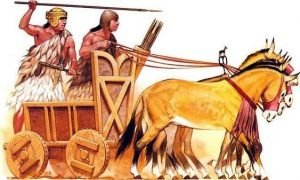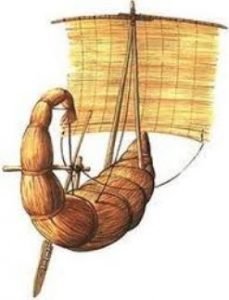7 Major Mesopotamian Inventions
The ancient Mesopotamian civilization brought forth groundbreaking inventions and discoveries which redefined their way of life. Even though their first settlements lived in primitive homes, the Mesopotamian people multiplied with time and crossed boundaries to create cities. The following is a list of 7 major inventions we owe to the ingenuity of ancient Mesopotamian civilization.
The Wheel

The wheel, a key Mesopotamian invention. Image source: Linoit.com
Mesopotamians were the first humans to conceive and invent the wheel with the view to using it for transportation purposes. As early as 3500 BC, the circular structure was already in use. Historians believe that the oldest ancient wheel was found in 2002, in Ljubljana, the Slovenian capital town. Therefore, they named it the Ljubljana Marshes Wheel. The age of the wheel was estimated to be about 5000 years old.
When the wheel was invented to aid transportation purposes, it was only the wealthy people who could afford it. The wheels were not only used for transportation. They were also employed in irrigation, milling and making pots. The invention of the wheel went on to inspire Mesopotamians to develop new technologies such as the chariot.
The Chariot

An image of the Chariot, being attached to a horse. Image source: Busy.org
Agriculture became a profitable business which allowed Mesopotamians to rear and domesticate animals. When the domestication of animals became a success, Mesopotamians realized that animals could provide enough mechanical power to convey people and goods from place to place.
They invented the chariot (a carriage) to be used in conjunction with animal power. Bulls and horses were attached to the chariot by using ropes. When the animals are persuaded to move, the chariot is drawn along the path of the animals. This innovation changed the life of the Mesopotamian people; they had just discovered a more efficient way of transportation. The chariot was also used by Mesopotamians to do sporting activities and fight wars.
The first chariots built in 3200 BC, were designed out of wooden parts. The wheels, body, and rim were all carved out of wood. The animal-drawn chariots gave a wonderful riding experience to the Mesopotamian civilization. The wealthy people and royals (kings and queens) took comfortable rides in their chariots.
The chariot stayed in place until future generations got smarter and introduced motorized vehicles. Nevertheless, the contribution of Mesopotamian civilization to modern civilization can never be downplayed. Factually, one good thing leads to another.
The Sailboat

The invention of the sailboat enhanced trade across borders. Image source: Mesopotamianblue55
Ancient Mesopotamian engineers got more determined to break boundaries and make their lives easier and better. With the invention of the animal-drawn wheels and chariots, Mesopotamians could comfortably travel by land to farther places. How about water? The Sumerians wanted to move across rivers, seas, and other water bodies. Therefore, they invented sailboats to travel on water. They successfully invented the first sailboats which were powered and navigated by humans. The boats were used by Mesopotamians to explore and fish in the Tigris River and the Euphrates rivers. Once again, they had an awesome experience floating and moving through water.
The first boats were carved to have a square shape, with the sail made from a piece of cloth. This primitive boat relied on the direction of the wind before it could operate. Unfortunately, they couldn’t change their course without using a favorable wind direction. But the invention was still a game changer.
The Plow (plough)

The plow was invented to enhance agriculture. Image source: Artnet.com
Mesopotamians took much interest in agriculture. They sought ways to till their land and improve crop production. This was achieved by inventing devices which could be pulled through the soil, to break and loosen it. Mesopotamians realized that they could use animal power from cattle (oxen) to pull plows and loosen the soil. This marked the invention of the plow. They named the first plow as “Ard”. Even though the ard was wood-made, it was heavier in mass.
One other weak point of the plow: it could get stuck by debris which had to be timely removed with the hand. When used on harder and thickly grassed lands, the plow lacked enough power to move through the resistance. Despite the challenges faced by Mesopotamians in using the plow, the device still revamped their agriculture.
Time-Measuring Devices
Mesopotamians also manufactured instruments that could record the passage of time. They were even the first civilization to conceptualize time. The Mesopotamian civilization were the first people to break down units/divisions for time. Their time system gave us 60 seconds = 1 minute and 60 minutes = 1 hour. The Babylonian people did astronomical computations which were based on the number “60” (hesagesimal system). Babylonians inherited that system from the Sumerians. The reason for 60 being chosen was that it is a number which easily divides by 6.
Astronomy and Astrology
The Mesopotamian civilization were also the first people to observe heavenly bodies such as planets and stars. They used the movement of the stars to time their planting seasons. Mesopotamians grouped stars into constellations. They also tried to find a correlation between the movement of heavenly bodies and their effects on people’s lives (this was the foundation of Astrology). Modern Astronomy is now a scientific field which involves the study of celestial bodies in outer space (beyond the Earth’s atmosphere).
Writing
As Mesopotamian flourished in agriculture and commerce, it became necessary for them to record their trades and transactions. Aside from that, they needed to document their cultural values and store them for future generations. Mesopotamians solved a scripted communication problem, by inventing the first method of writing, known as cuneiform. Cuneiform was a pictorial form of writing – it wasn’t an easy thing to learn but it afforded Mesopotamians a means to record their own history.
Other social inventions of ancient Mesopotamia
The list of Mesopotamian inventions extends to many areas in science, mathematics, law, medicine, architecture and more. However, they also instituted laws and government systems which are still practiced by today’s society. For example, Mesopotamians instituted monarchies to rule their people. The Sumerians had kings who reigned over territories. They also proposed laws to punish unlawful people. In summary, ancient Mesopotamians were geniuses who introduced jaw-dropping innovations. Let’s give them the credit.



























